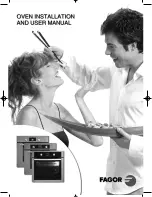
Page: 10
Microwave cooking tips
1) Arrange food carefully, place thickest areas toward outside of dish.
2) Watch cooking time, cook for the shortest amount of time indicated and add more time as needed.
3) Cover foods before cooking
check recipe for suggestions: paper towels, microwave plastic wrap or a lid.Covers prevent spattering and help foods to cook
evenly. (Helps keep oven clean).
4) Shield foods
Use small pieces of aluinium foil to cover thin areas of meats or poultry to avoid overcooking.
5) Stir foods:From outside to center of dish once or twice during cooking, if possible.
6) Turn foods:Foods such as chicken, hamburgers or steaks should be turned over once during cooking.
7) Rearrange foods: Like meatballs halfway through cooking both from top to bottom and from the center of the dish to the outside.
8) Allow standing time
After cooking ensure adequate standing time.Remove food from oven and stir if possible.
Cover for standing time which allows the food to finish cooking without overcooking.
8) Check for doneness
Look for signs indicating that cooking temperature has been reached. Doneness signs include:
-Food steams throughout, not just at edge.
-Poultry thigh joints move easily.
-Pork and poultry show no pinkness..
-Fish is opaque and flakes easily with a fork.
9) Condensation
A normal part of microwave cooking. The humidity and moisture in food will influence the amount of moisture in the oven. Generally
, covered foods will not cause as much condensation as uncovered foods. Ensure that the ventilation openings are not blocked.
10) Browning dish
when using a browning dish, always place a heat-resistant insulator such as a porcelain plate under it to prevent damage to the
turntable, rotating ring due to heat stress. The preheating time specified in the dishes instructions must not be exceeded.
11) Microwave safe plastic wrap
for cooking food with high fat content, do not bring the wrap in contact with the food as it may melt.
12) Microwave safe plastic cookware
Some microwave safe plastic cookware are not suitable for cooking foods with high fat and sugar content.
Cleaning and maintenance
Disconnect the power supply cord before cleaning. And if possible leave the door open to inactivate the oven during cleaning.
Exterior:
The outside may be cleaned with mild soap and warm water, wipe clean with a damp cloth. Avoid theuse of harsh abrasive cleaners.
Door:
Wipe the door and window on both sides, the door seals and adjacent parts frequently with a damp cloth to remove any spills or
spatters. Do not use abrasive cleaners.
Control panel:
Care should be taken in cleaning the control panel. Wipe the panel with a cloth dampened slightly with water only.Do not scrub or use
any sort of chemical cleaners. Avoid the use of excess water.
Interior walls:
To clean the interior surfaces, wipe with a soft cloth and warm water for hygienic reasons. After usewipe the waveguide cover
in the oven with a soft damp cloth to remove any food splashed. Buildup splashes may overheat and begin to smoke or catch fire.
Do not remove the waveguide cover. Do not use a commercial oven cleaner, abrasive or harsh cleaners and scouring pads on any
part of your microwave oven. Never spray oven cleaners directly onto any part of your oven.Avoid using excess water. After cleaning
the oven, ensure any water is removed with a soft cloth.
Turntable/ Rotating ring/Rotating axis
Wash with mild soapy water and dry thoroughly.
TIP:
When the microwave oven has been used for a long time, there may be some strange odors exist in
oven, Following 3 methods can get rid of them :
1. Place several lemon slices in a cup, then heat with high power for 2-3 min.
2. place a cup of red tea in oven, then heat with high power.
3. Put some orange peel into oven, then heat them with high power for 1 minute.
Below listed condition may cause undue microwave exposure during servicing.
1. Unproper fitting of magnetron.
2. Unproper matching of Door interlock, door hinge and door.
3. Unproper fitting of switch support.
4. Door, Door seal or enclosure has been damage.
During servicing below listed parts are liable to be removed and give access to potentials above
250
V to earth.
1. Magnetron 2. High voltage transformer 3. High voltage capacitor 4. High voltage diode 5. High voltage fuse
Warning: it is hazardous for anyone, other than a qualified service technician, to carry out any service for repairing
operation which involves removal of any cover which gives protection against exposure to microwave energy.
Caution: MICROWAVE RADIATION
Do not become exposed to radiation from the microwave generator or other parts conducting microwave energy.
Servicing
Summary of Contents for SMW736
Page 12: ......






























